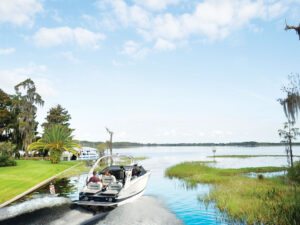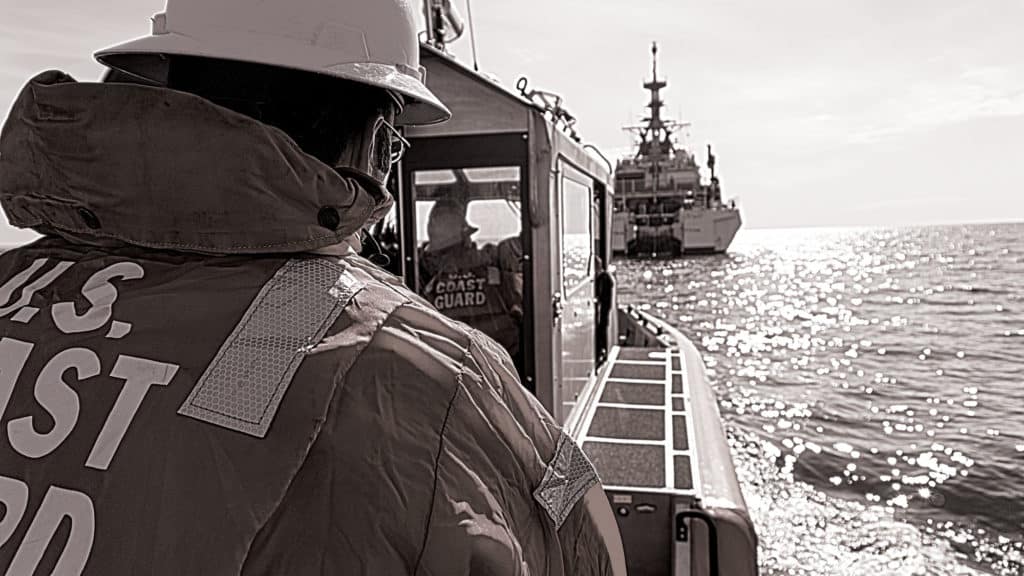
Green water was coming over the bow of the Stratton about every 10th wave. We were making maybe 5 knots, a speed we’d hold for two days to maintain steerage into the estimated 15-foot seas while keeping the ship’s crew from tossing their cookies. Only a half-dozen or so crewmen manned the command deck when I climbed to the bridge, and all were marveling at the malevolent violence of the Chukchi Sea just north of the Bering Strait that June day in 2018.
Our ship, the 418-foot USCGC Stratton, was assigned to a dual mission. First was a community-relations tour to assist three local communities in training fishermen and boaters in self-rescue techniques in the frigid arctic waters. Diomede, a village on a nearly flat rock in the Bering Strait, and Wales, on Alaska’s eastern peninsula, are both Inuit outposts we had already left in our wake the night before because seas that began at 8 feet in the narrow strait made small-boat landings impossible, and the pitch and roll of the deck exceeded the parameters for non-emergency chopper flights.
The second half of the mission was to refresh the crew at Kotzebue —a recently opened Coast Guard detachment and the first ever above the Arctic Circle. Kotzebue was founded in response to the diminishing ice in the Arctic and the resulting expansion in marine traffic—commercial, military and recreation. Kotzebue would be our jumping-off point—if we could figure a way off the ship.
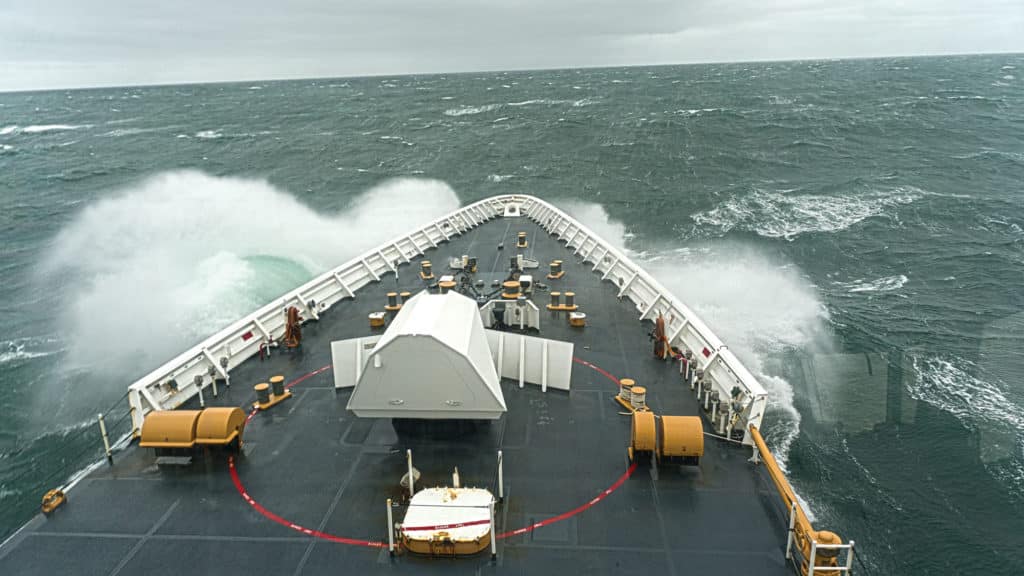
Thanks to the 15-foot seas, the small boat that brought us from Nome to the Stratton was out of commission. Each time the Stratton crested a wave, a following wave crashed over the same transom doors that had swallowed our diesel-powered jet boat a day or so earlier. Every wave—each a 1,000-gallon battering ram—crashed onto the engine-compartment hatches, crushing them. We held that idle-speed northbound pattern for the next two days. The MH 65 Dolphin rescue choppers, one resident on the Stratton and one based in Kotzebue, were our only way off the ship.
This was nothing like our departure from Nome 24 hours earlier. We had all milled about the fishermen’s wharf inside the Nome breakwaters, wearing light jackets in the warming sun and waiting for our ride to the Stratton. Several new ensigns, fresh out of the academy, all women, stood around their gear, lip-syncing and head-banging to music from a Bluetooth speaker.
Altogether, about 15 crewmen, one Alaska boating safety specialist and I would take the small boat to the back door of the Stratton in two trips. That was easy in the calm, nearly flat seas. The tough part was getting into the dry suits required by safety regulations for the 15-minute transit from the dock to the ship.
We slid into the center bay astern the Stratton, and crewmen handed up our gear as we clambered to the main deck. The transom doors slid closed behind the small boat—a James Bond-like arrangement that proved troubling 24 hours later in the seas we now watched from the command deck. The calm seas of Nome turned into 8-footers as soon as we rounded the protected waters into the Bering Strait.
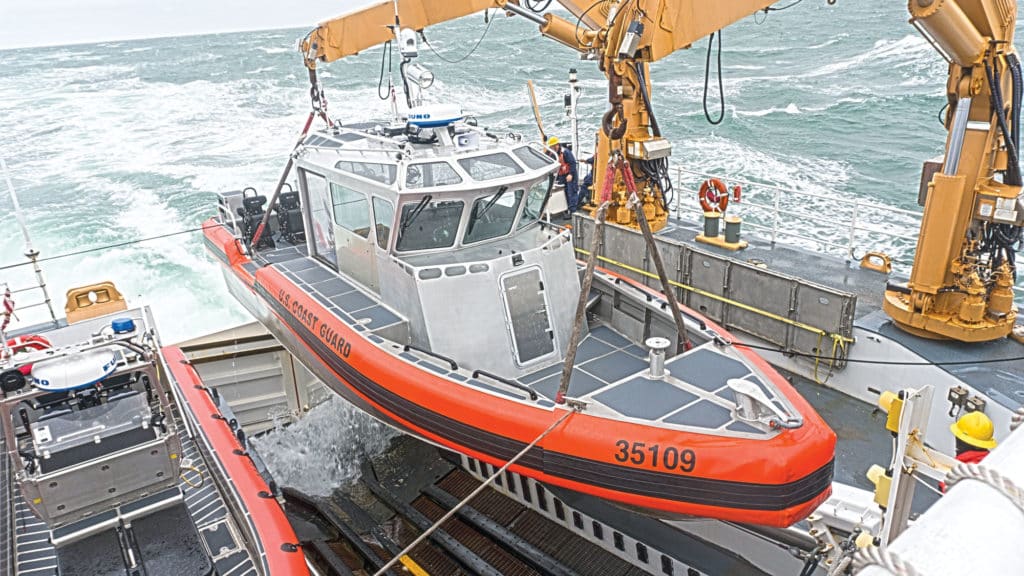
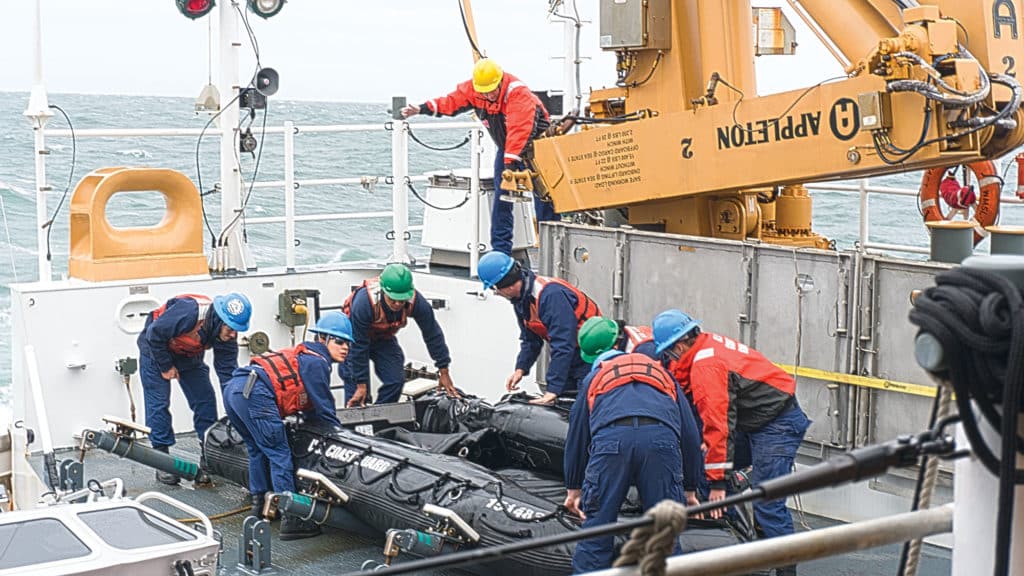
We hadn’t been at sea eight hours when a call from the sick bay came over the ship’s intercom, announcing it would be open to dispense Dramamine for only the next 15 minutes. I wondered if the short window of opportunity was a sort of hazing to make sure the green new ensigns fresh from the Coast Guard Academy were conspicuous as they beat it down to the sick bay.
So, with our COMREL mission scrubbed and the ship in a holding pattern for the next three days, I settled in and decided to become an observer of ship life. It was a chance to chart the career path of several Coasties to see why just about 80 percent of enlistees re-up at the end of their first tour.
I shared a berth with Commander Mark Neeland, a studious, soft-spoken officer temporarily aboard the cutter for the COMREL mission. He kindly left me the bottom bunk. We had our own head and shower, and the cabin was illuminated by a choice of either glaring fluorescent tubes or red lights that showed the way, ruining your night vision.
It took me the whole three-day cruise to learn how to find that cabin on the first try whenever I returned. It was down two decks from the mess hall, but only if you turned left at the silverware and right at the commissary. Make a wrong turn, and you get to the only spot I wasn’t allowed to visit—the ship’s turbine engine that worked in partnership with its diesels.
Getting a week’s worth of camera, computer and personal gear through the narrow deck hatches and up and down the steep gangways was a chore, but by the end of three days, muscle memory made the empty-handed passage almost second nature.
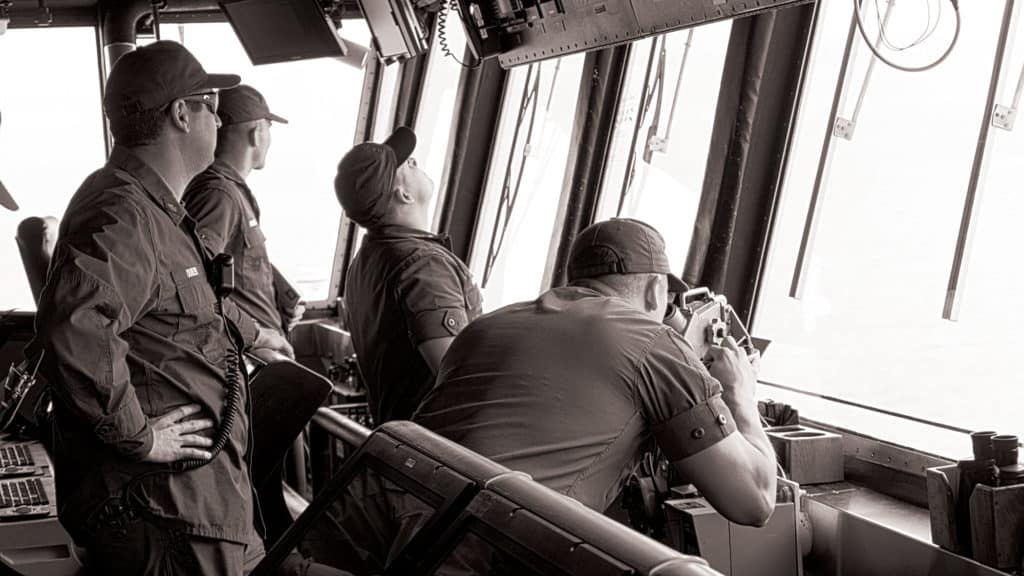
Making Commander
My ignorance of Coast Guard insignia meant I didn’t realize Commander Neeland was the second highest-ranking officer aboard the Stratton until I noticed crewmen in the passageways make a hole as we passed by.
“So, where’s your ship?” I asked Neeland later.
“There are all kinds of ways to make a career in the Coast Guard,” Neeland replied. “I’m an engineer.”
Many officers aim toward a ship’s command as they progress through the ranks of the Coast Guard. It is usually expected that you do so. Saving lives and protecting maritime traffic is one pathway to an outstanding career in the Coast Guard. But not the path Neeland chose.
Like most officers in the Coast Guard, Neeland entered, 17 years earlier, through the Coast Guard Academy, where he earned a Bachelor of Science in naval architecture. He later followed that with a master’s in engineering from the academy, and another master’s in industrial operations and engineering from the University of Michigan.
For a recruit, the career pathway begins with the Armed Services Vocational Aptitude Battery test. The ASVAB measures your skills in math, language, and mechanical and electrical disciplines, among others. An appointment to the United States Coast Guard Academy requires an outstanding academic career, extracurricular activities that point to an aptitude of leadership, and it doesn’t hurt to have a letter of recommendation from your congressman.
Only 15 percent of applicants are accepted into the academy. Navigating a Coast Guard career can be trickier than running the Chukchi’s 15-foot seas.
“If you aren’t promoted by the second tour, you should be looking for a new career,” Neeland says. In fact, according to Neeland, they can muster you out.
Neeland’s favorite job was in maritime safety review for commercial rules.
“We made sure unsafe vessels weren’t certified for sea duty. It is a good place to make a difference,” Neeland says, referring to the resulting lives saved by helping the industry commission safe vessels.
How do you make admiral?
“Well, if you have stars in your eyes, you have to do well at everything,” Neeland says. “Some jobs can open a door for you, and other jobs can close one.”
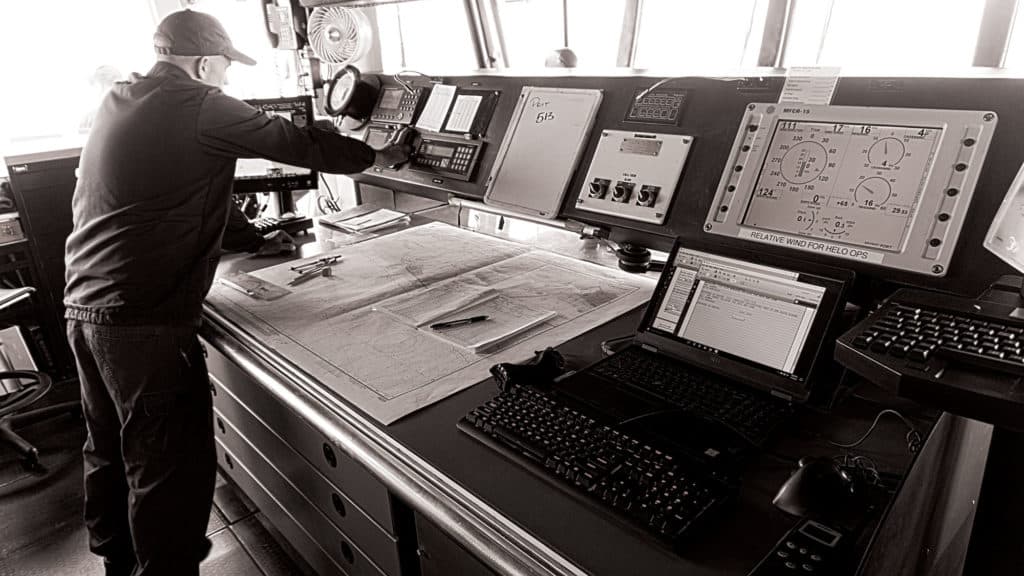
Civilians On Board
The Stratton has two chopper hangars on the aft deck, and we entered through the port hangar occupied by a handful of card-playing civilians. They were surrounded by sturdy cargo boxes and an ominous catapultlike rail on wheels. Turns out, the Stratton is the first cutter to deploy in the Arctic with a surveillance drone.
The “tyranny of distance” is a phrase you’ll hear aboard a Coast Guard cutter almost as frequently as “semper paratus,” always ready. The drone closes that gap quickly before anything else can get there. With its day- and night-vision camera, it can read a license plate at 3,000 feet.
The drone helps chopper pilots and rescue swimmers plan the best approach to an emergency long before the cutter or even the Dolphin choppers can make it on location. It has been used on drug interdictions too, and at least some of the marijuana leaf and snowflake icons representing drug busts are credited to that drone. We wouldn’t get to see the drone launch from its ominous-looking rail thanks to the conditions and, well, the absence of a real mission, and so we also wouldn’t get to see it crash-land gracelessly into its recapture net.
The multimillion-dollar drone weighs just around 50 pounds, and I was surprised when they let me hoist it for a selfie.
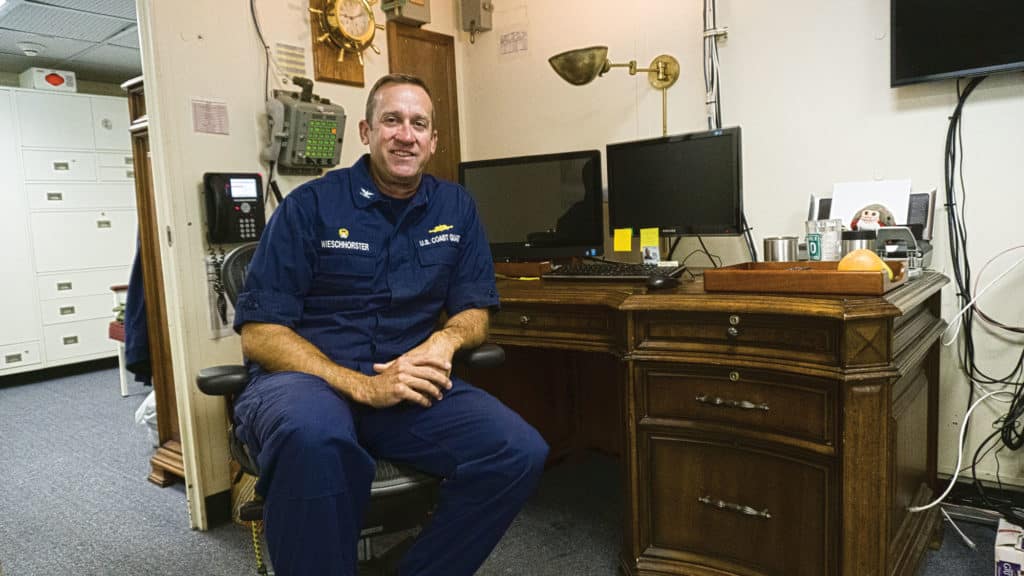
Captain’s Log
When we weighed anchor at Nome, the captain stood ahead of the consoles at the windows facing forward, his coffee-filled Yeti stationed in a custom mahogany rack on the sill. I’d hate to be anywhere on board when that rack was needed to keep the cup in place on the Stratton. Capt. Craig J. Wieschhorster quietly called out commands to his crew, who executed them and repeated them back.
At lunch in the officers’ mess, I took the nearest open chair.
“That’s Captain Sauce’s seat,” other officers protested. The captain was nowhere to be seen.
Captain Sauce? His name certainly looked like Worcestershire—and his seat was off limits.
Wieschhorster’s quarters were above the command deck. He invited me in, and I lurched toward an overstuffed chair. On this uppermost deck, the Stratton‘s pitch and roll were most noticeable, according my belly. I couldn’t take notes and hold my stomach, so much of his career history went unwritten.
During the departure of the ship’s Dolphin chopper, I stood on the cramped flight command deck shoulder to shoulder with the captain and the flight-deck controller.
This was a critical job, choosing the ideal moment for the chopper to lift off between the worst of the waves, and the officer spoke softly to Lieutenant Amanda Harris at the Dolphin’s stick. Each revolution of the Dolphin’s rotor passed the glass of our cubbyhole by an astonishingly slim margin.
The captain was silent, and if the flight controller was nervous, he didn’t show it. The chopper lifted clear and passed forward of the ship, out of sight.
“Good work,” the captain whispered and left.
I don’t know what it would be like to be “dressed down” by Captain W., but it would probably be done in good humor.
Read Next: Ride Along With Water Cops
The food on cutters is usually a highlight of the ship’s life, but I’d just tried to stick a fork in what was described on the chalkboard menu as chicken cordon bleu. After finally penetrating the over-crispy shell, my fork buried itself in the undercooked center.
The captain chewed his for an overly long time and swallowed.
“Nothing says Sunday dinner like chicken cordon bleu,” he exclaimed wryly.
The weather laid down beautifully for our 20-minute flight to Kotzebue. Strapped in, I was able to lean out the door and snap pictures of the Stratton as she steamed slowly ever north. I hadn’t asked of her next destination, but knew it would be somewhere between the North and South poles—hopefully in gentler seas.
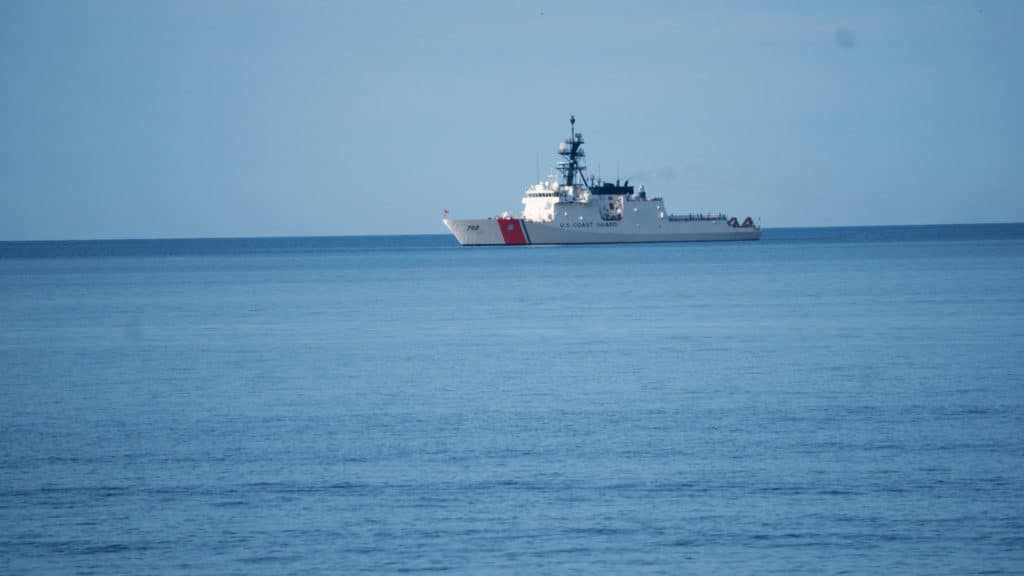
The Stratton
I was invited to dine in the officers’ mess aboard the Stratton, a privilege not always granted to visiting press. The narrow room had a long table with chairs that backed against the far bulkhead, and a coffee bar along the other wall. Above the bar, mahogany cubbyholes held mugs with officers’ names. Top and center was Michelle Obama’s.
The Stratton was named for Coast Guard Capt. Dorothy Stratton, a member of the Coast Guard Reserve during World War II. In 2012, First Lady Michelle Obama christened the ship, and the Stratton has been sailing from the Pacific to the Arctic ever since. It’s been doing drug interdictions, search and rescue, community relations, and maintaining a U.S. presence in the Arctic at a time when receding ice and increasing demand for Arctic oil create more international competition for resources. Increasingly, Russia prospecting in the Arctic has challenged our universal presence, building more than a half-dozen ice-breaking ships in the past few years. Even China is cruising into the Arctic, creating a critical need for an increased U.S. presence that supports international maritime laws in this remote location.
The Stratton is lightly armed with two radar-aimed 20 mm deck guns. We passed the aft gun surrounded by a pile of expended brass, and one made an excellent souvenir. The Stratton‘s bones are the same used by the Navy in light destroyers, making it possible to refit the cutter for defense purposes, and giving the U.S. armed services the economy of a shared platform for both branches.
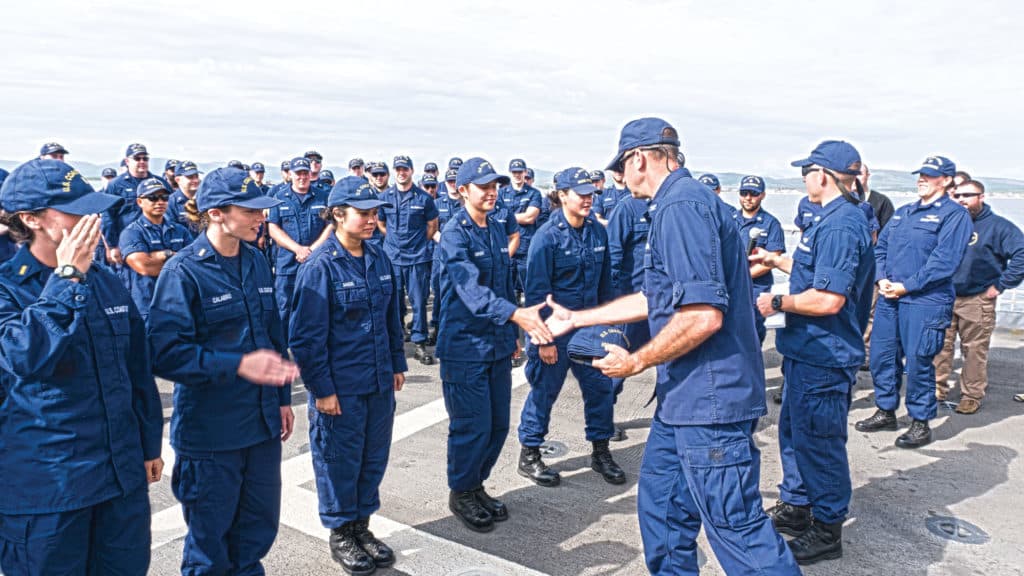
The Newbies
The new ensigns to board with us at Nome had varied backgrounds.
Katherine Haerr, from Plano, Texas, is a marine science major. She applied twice for the Coast Guard Academy before she was accepted. Her toughest entry challenge was the aerospace test. With a tough academic attitude and a bright outlook, ensign Haerr chose the Coast Guard “because of its humanitarian mission with military bearing.”
Ensign Kiera Foster, of Navarre, Florida, is an engineer. The athletic woman was a volleyball player whose entire family pursued military careers. A disciplined academic, she entered the academy without a congressional nomination, strictly on her leadership and academic skills.
“It’s kick-ass on this ship, but I hope to pull duty in Bahrain someday,” she says, maybe half seriously. “I’ll be commander in 20 years, or I’ll own a snow-cone shack in Hawaii. All you need is a shack and an ice maker.” Moments before I flew off the Stratton, she pressed a tightly folded paper in my hand. I remembered it after landing in Kotzebue and unfolded the pencil sketch of a snow-cone shack made of surfboards.
Olivia Calabro, of Madison, Connecticut, lived near the Air Force Academy and always wanted to go there—until she heard about the Coast Guard Academy.
“I am so happy I am here,” says the passionate, engaging, self-acknowledged smartass. “The Coast Guard’s new environmental mission was for me, so I decided to go for it, and here I am!”
For all her bluster, Calabro’s nonacademic life was spent around church activities and sports.
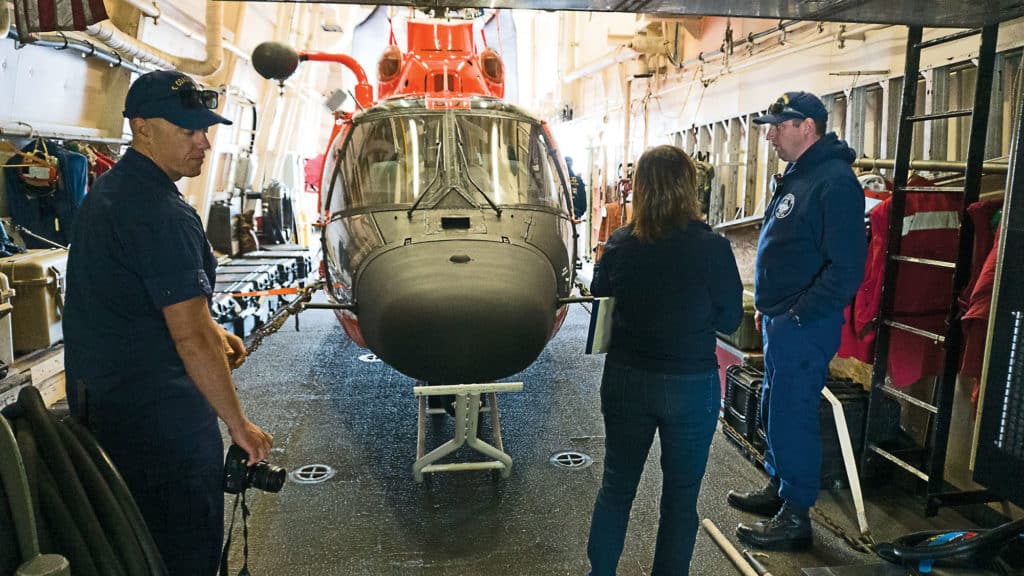
Flying High
Lieutenant Amanda Harris was one of our chopper pilots, and after chatting with her in the officers’ mess, I hoped she would be my ride to Kotzebue. She flies the upgraded MH 65 Dolphin that boasts 40 percent more horsepower than the HH 65.
Harris has been in the Coast Guard for more than 10 years. She got her wings at the Pensacola Naval Air Station. Her father was a retired Coast Guard pilot, and he pinned his wings on Harris. If you think a Coast Guard pilot is a glorified bus driver, think again. Harris’ degree is in engineering, and she interned and then worked at an engineering firm while she applied the first and second successful time for her flight spot.
Operated by Insitu, Mike McCord is the drone pilot.
“The Scan Eagle drone can fly 18 hours on a gallon and a half of jet fuel,” he says. “That allows us to get eyes on situations over the horizon in stealth and long before the Stratton can put assets on the scene.”

